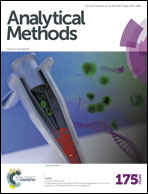Detection of low molecular weight adulterants in beverages by direct analysis in real time mass spectrometry†
Abstract
Direct Analysis in Real Time Mass Spectrometry (DART-MS) has been used to detect the presence of non-narcotic adulterants in beverages. The non-narcotic adulterants that were examined in this work incorporated a number low molecular weight alcohols, acetone, ammonium hydroxide, and sodium hypochlorite. Analysis of the adulterants was completed by pipetting 1 μL deposits onto glass microcapillaries along with an appropriate dopant species followed by introduction into the DART gas stream. It was found that detection of these compounds in the complex matrices of common beverages (soda, energy drinks, etc.) was simplified through the use of a dopant species to allow for adduct formation with the desired compound(s) of interest. Other parameters that were investigated included DART gas stream temperature, in source collision induced dissociation, ion polarity, and DART needle voltage. Sensitivities of the technique were found to range from 0.001% volume fraction to 0.1% volume fraction, comparable to traditional analyses completed using headspace gas chromatography mass spectrometry (HS-GC/MS). Once a method was established using aqueous solutions, fifteen beverages were spiked with each of the nine adulterants, to simulate real world detection, and in nearly all cases the adulterant could be detected either in pure form, or complexed with the added dopant species. This technique provides a rapid way to directly analyze beverages believed to be contaminated with non-narcotic adulterants at sensitivities similar to or exceeding those of traditional confirmatory analyses.


 Please wait while we load your content...
Please wait while we load your content...